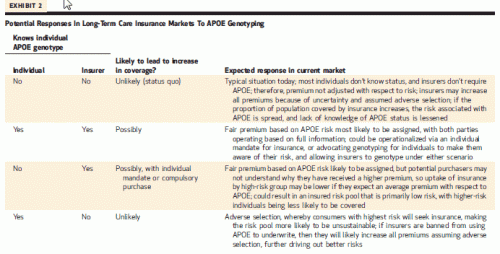Following up on this morning’s post…The Genetic Information Non Discrimination Act of 2008 (GINA) makes it illegal for health insurers and employers to use genetic information to discriminate based on the results of genetic tests. However, the law does not ban the use of such information for LTCI, disability or life insurance. Some states have banned the use of genetic markers for LTCI. Thus, a genetic marker such as APOE4 (e4) that has been shown to predict admission to a nursing home (NH) in a community based sample could be used to underwrite LTCI policies in some states.
However, there are apparently no LTCI companies who are using such information to underwrite policies.
The meta idea of GINA is to protect consumers against the actions of insurance companies. However, I believe that in the case of LTCI, this perspective may be limited, and that lower risk consumers who desire LTCI coverage may be harmed by the current regime in which individuals who are at a higher risk for NH admission based on genetic markers have this information while insurers do not. This may result in higher risk consumers receiving a premium that is too low, while lower risk consumers receive one that is too high. Further, adverse selection may mean that the premiums for a LTCI company’s pool of covered lives may be too low. When this occurs, and outlays are larger than premiums, company’s typically ask states for permission to increase premiums, even though most LTCI policies have level-premium guarantees. In such cases, state regulators have the uneviable task (p. 9-11) of granting such increases, or risking the insurance company going under. This leads some consumers to drop coverage as their probability of needing care increases (good brief on LTCI; many issues covered).
Correct policy depends upon what type of fairness is viewed as paramount. A GINA-type ban of using genetic markers views it as unfair to penalize someone for their genes, which they got from their parents after all. In insurance terms, however, fair means the correct premium with respect to the rest of the pool, especially in a voluntary private market. Expansion of the size of the market is important to spread the risk and lower premiums, as well as to increase planning ahead for LTC, which could reduce public outlays for such care.
Exhibit 2 of a recent paper lays out the likelihood of private LTCI coverage rates increasing based on who has genetic information (consumer, insurer).
Adverse selection is typically viewed as hurting the insurer only, but it can also harm lower risk consumers. The chance of this happening seems heightened with a very small market such as private LTCI. If the policy goal is to expand private coverage and to assign a fair premium, the use of genetic information could aid in achieving this goal if both “sides” know and understand the information. Of course, the larger the risk pool, the less important underwriting becomes.
In the wake of CLASS demise, there are many things that can be done to expand LTC coverage. However, it will take policy steps and some type of forced risk pooling. The private LTCI market is small, and unlikely to play a larger role with no substantial policy changes.


